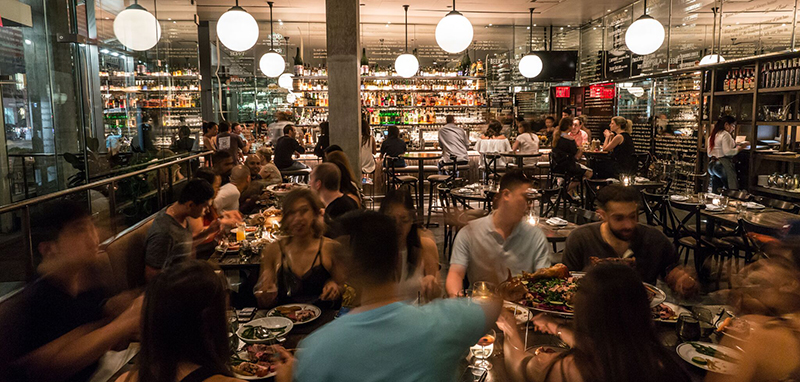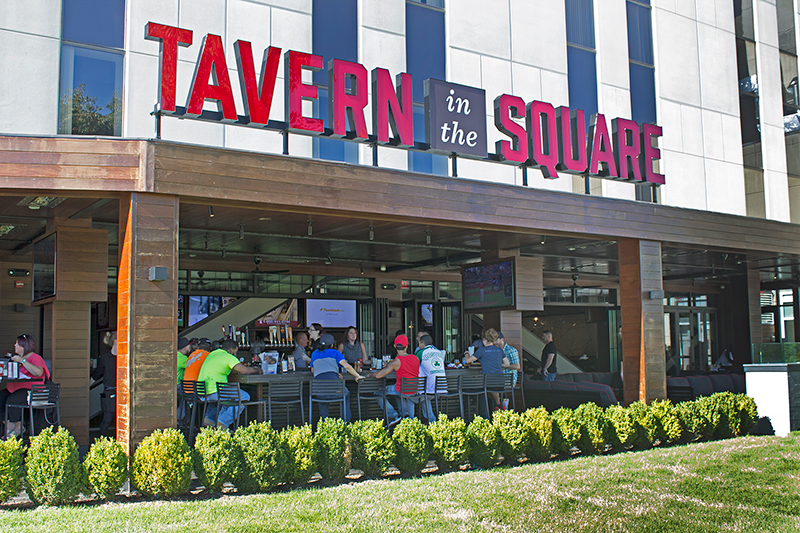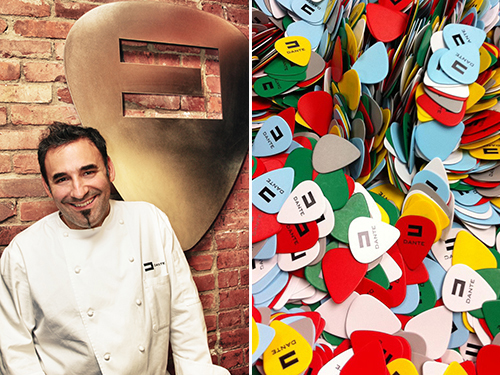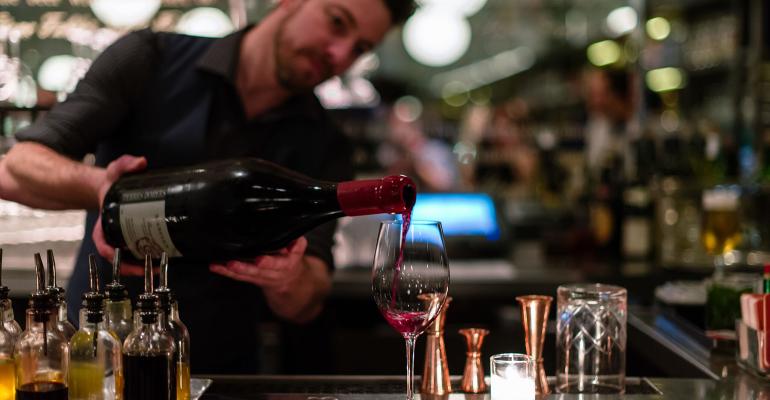You’re pretty sure you can get them in the door once, especially if you’re the hot restaurant in town and you’ve just opened. Reservations have been booked for months. The press is clamoring for interviews. Social media is going wild with photos of your dishes.
But there’s always the nagging fear: Once the excitement wanes, will those guests come back?
At a time of short attention spans and social-media-fueled hype for the Next Hot Shiny Restaurant, it has become more important than ever for operators to make a concerted effort to build loyalty among guests.
OpenTable recently estimated that only about 5 percent of restaurant diners on average return to the same restaurant within the next 12 months.
 That’s shockingly low. At a time when the restaurant industry is more saturated than ever before, the challenge for restaurants is to be smarter about how they cultivate and keep the attention of their core diners.
That’s shockingly low. At a time when the restaurant industry is more saturated than ever before, the challenge for restaurants is to be smarter about how they cultivate and keep the attention of their core diners.
Some operators argue that, fundamentally, it’s still the age-old basic principals of hospitality that brings guests back: offering good food, warm, attentive service and personal touches that can cap an extraordinary experience.
But a growing number of independent restaurants are using contemporary techniques and technology to enhance those basic principals.
Others are taking a more segmented approach to marketing, and some are borrowing from the chain restaurant world by launching loyalty programs to build a pool of fans that will return again and again.
Chef and restaurateur Suzanne Goin of The Lucques Group in Los Angeles, parent to the restaurants Lucques, AOC, Tavern and The Larder, recently lamented the number of restaurants forced to close in recent months in this challenging operating environment. She said the news is typically met with howls of protests from fans, who say, “No, no, don’t go!”
Meanwhile, she said, those operators find themselves wondering of those fans, “Then why didn’t you come when we were here?”
Opening new restaurants is sexy and exciting, she said. “But the real work comes in keeping places great and growing years after the opening buzz is over.”
KEEPING A CUSTOMER PROFILE
Perhaps more than anything else, restaurant operators say a key to building loyalty is knowing your guests’ preferences, from the type of wine they prefer, to the ingredient they’re allergic to.
That intel was once kept in a maître d’s little book tucked into his breast pocket, or in a notebook behind the host stand. Today, that information is more likely captured with technology.
Reservation and table management services now allow restaurants to create profiles of guests with details like whether they are vegetarians, if they favor cocktails before dinner or have a favorite table.
 TABLE MANNERS DBGB Kitchen & Bar and other Dinex Group restaurants learn what the customers want, and don’t want, to keep them coming back. (Photo: Paul Wagtouicz)
TABLE MANNERS DBGB Kitchen & Bar and other Dinex Group restaurants learn what the customers want, and don’t want, to keep them coming back. (Photo: Paul Wagtouicz)
For multi-concept operators like The Dinex Group, based in New York, that information can follow the guest from concept to concept, which not only builds loyalty at the individual restaurant level but for the company as a whole, said Michael Lawrence, Dinex director of operations.
Dinex is parent to Daniel Boulud’s collection of restaurants, including the famed Daniel and The Bar at Daniel, as well as DB Bistro Moderne, DBGB Kitchen & Bar, Café Boulud and Boulud Sud.
“So if you’re a regular at Café Boulud and you go to Boulud Sud, we can see that you like the grapefruit, that you often come with young children, what allergies you have or what wines you prefer, like that you prefer Chablis over sauvignon blanc,” he said. “We train our staff to be perceptive to these things, and, once they leave, if it’s something important, you jot it down.”
Having that information readily at hand allows the service staff to convey a level of warmth and engage more with guests in a way that makes all of the group’s restaurants feel like “a friendly port,” whether in Montreal or Palm Beach, he added.
“People don’t come to us simply for nourishment, they come for an experience and for the people. We like to hire people that have the hospitality gene,” said Lawrence. “I would rather hire somebody who has a smile, good energy and personality than someone with 10 years of experience in the finest restaurant in the world who doesn’t have that personable touch.”
BUILDING SUPER FANS
At Aroma Thyme Bistro in Ellenville, N.Y., owner Marcus Guiliano uses technology to track guest visits and spending. That information helps shape how he markets his restaurant to his fan base.
Aroma has a loyalty program, which allows guests to earn points for every dollar spent toward a certificate that can be redeemed for free food. The 60-seat restaurant has between 5,000 and 6,000 loyalty members, including some that have been repeat customers since the restaurant first opened nine years ago, said Guiliano.
“Industry statistics show that it’s six times easier to get back a repeat guest, versus a new guest,” he said. “The people who come into my restaurants are guests, not customers. A customer is a transaction. A guest is someone you value and who you’ve invited into your home and business, and who you want multiple transactions from.”
Developed with a company called Royalty Rewards, Aroma Thyme’s loyalty program allows the restaurant to track spending by those guests.
“Tracking your guest spending is super important,” he said. “Tracking where they come from is super important so you know where to put your advertising dollars.”
Aroma Thyme’s loyalty members spend an average of $6,800 over five years, he said. As an expression of appreciation, each year Guiliano throws parties for the top 50 spenders, both top spenders for the year and top spenders for life.
Usually set during slow periods, the restaurant closes down for a few hours, or uses a back room for the informal buffets, which are free, though the restaurant has to charge for drinks because it’s illegal to give alcohol away in New York, he said.
Often, the restaurant will test new dishes at the top 50 celebrations, or bring out ingredients like mushrooms that Guiliano has foraged for personally.
At the events, he makes a point of speaking with guests at every table and telling them how much their business means to him and his family. He also brings his staff out and thanks them.
“Our guests want to know we’re real people,” he said. “They want to know if our kids play baseball or where we took a family vacation. And people want to know that they’re appreciated.”
The result is those top spenders become even more loyal, said Guiliano.
“People walk in and give us gifts,” he said. “It’s amazing, the vibe and the loyalty that this one thing does.”
But that’s not all Aroma Thyme does to generate loyalty.
He and his servers send out personal thank you cards, Guiliano said.
The restaurant also keeps a shuttle van on hand to do group hikes or brewery tours. The van will also pick up tourists from area hotels and brings them back after dinner.
“People really like that,” he said. “They may not be repeat customers, because they’re tourists, but they’ll mention it on Yelp or TripAdvisor.”
The restaurant also lights a fire pit outside during the summer where free s’mores are served to families and their kids — a loyalty move that also helps turn tables when guests want to linger, said Guiliano.
The restaurant also keeps an email newsletter list to keep fans engaged. “Guests like to hear from you every 21 days,” he said.
BRINGING THE DISCOUNTS
In Boston, the 10-unit Tavern in the Square also launched a loyalty program using Paytronix in February that allowed the restaurants to track guest usage.
“This was an eye-opening experience,” said Stephen DeSousa, Tavern in the Square’s CEO. “We learned so much about the analytical part of loyalty that gave us tools to better market our restaurants.”
 PROMOTION POWER Tavern in the Square’s “We miss you” email campaign traded free appetizers for big dividends approaching a hundred grand in one month. (Photo: Tavern in the Square)
PROMOTION POWER Tavern in the Square’s “We miss you” email campaign traded free appetizers for big dividends approaching a hundred grand in one month. (Photo: Tavern in the Square)
Early on, for example, the chain ran a “we miss you” campaign, reaching out to guests that hadn’t been in for a visit in 30 days. About 82 percent of those in the campaign were loyalty club members, he said.
The email offered a free appetizer to get them back in. Within four days, the restaurants saw a $20,000 spike in sales tied to the promotion alone. Over one month, the chain gave away $9,800 worth of food, but saw $96,000 in sales specifically from those guests.
“That really showed me the power of these promotions,” said DeSousa.
Now the chain has about 19,000 loyalty members, he said, which is growing at a rate of about 300 per week.
The loyalty program is an upsell feature for event bookings. If a nonmember calls to feel the restaurant out for an event, DeSousa pitches the loyalty membership, which offers a discounted rate. That usually clinches the booking, he said.
Tavern in the Square uses a physical card for loyalty members but there’s also an app. About 60 percent of loyalty members have downloaded the app.
Through the app, the restaurants can use geofencing to ping guests within a two-mile radius with a message offering a buy one, get one offer, for example, or some other promotion.
Fundamentally, loyalty members are driven by value, said DeSousa.
“But we’re learning that there’s a fan base that also likes to be included in decision making,” he said. “So we’re putting out questions and surveys and giving them the inside track to events. People want to know what’s happening, and I’m able to segment to people for events in certain locations that’s pertinent.”
DEVELOP A MEANINGFUL TRINKET
At Dante Dining Group, an eight-restaurant multiconcept operator based in Cleveland, Ohio, owner Dante Boccuzzi is decidedly less high tech.
At his flagship restaurants Dante in Cleveland and Dante Boccuzzi in Akron, Ohio, Boccuzzi gives out guitar picks with the brand’s signature letter D.
A guitar player himself, Boccuzzi was inspired by the simple clothespin Thomas Keller used to give to guests at The French Laundry in California.
 GUITAR MAN Dante Boccuzzi chose guitar picks emblazoned with the Dante Dining Group logo to build loyalty at his restaurants in the Cleveland area. (Photos: Dante Dining Group)
GUITAR MAN Dante Boccuzzi chose guitar picks emblazoned with the Dante Dining Group logo to build loyalty at his restaurants in the Cleveland area. (Photos: Dante Dining Group)
“You see it and you think about wanting to go back,” he said. “Maybe you don’t play guitar, but if you’re a golfer, you can use the pick as a ball marker, or just throw it into your junk drawer or your car.”
Unlike The French Laundry, Boccuzzi decided to give his guitar picks some value. If guests accumulate 10, they get a $50 gift certificate toward their next visit.
When he orders the picks in 12,000 or 20,000 batches, he’ll take a photo and send an email to guests asking them to guess how many are in the picture for a $100 gift certificate reward.
“People stop me on the street all the time and pull one of my guitar picks out of their pocket,” he said. “It reinforces the logo and the name. It’s really accomplishing the goal.”
Boccuzzi also uses comment cards on tables to capture both positive and negative feedback.
If a guest is not happy, he calls to apologize personally and fix the situation. “Whatever it takes,” he said.
To those who give good reviews, Boccuzzi or his assistant write a hand-written thank you note.
“That’s had a huge impact,” he said. “People will put it on their fridge and take a photo and send it to me. People remember that.”
Boccuzzi’s empire is growing, with a new restaurant called Dante’s Inferno opening in August and a couple more planned. Growth makes it difficult to keep that personal touch, but Boccuzzi said he’s determined to keep it up.
“It takes a lot of time,” he said. “But I think that’s what a lot of places are losing. It becomes like a factory and they’re pushing people in and out. We try to do things differently.”
PAYING ATTENTION TO DETAILS
Greg Atkinson, co-owner of Restaurant Marché on Bainbridge Island near Seattle, is not a believer in loyalty programs to get guests to come back.
“There’s no one way,” he said. “You build customer loyalty one customer at a time.”
The former executive chef at the acclaimed restaurant Canlis in Seattle, Atkinson decided to open Restaurant Marché about five years ago with his wife. It’s a small restaurant in a small community, where the couple makes a point of touching each table every night, he said.
“I realize that each one of our guests could get their 2,000 calories a day anywhere. There’s a grocery store across the street. But what people want is for someone to notice them, to give them attention for a minute,” he said.
Restaurant Marché has an open kitchen so guests can sit at the bar and watch Atkinson cook.
“Some people want to see something new all the time, so I have a chef’s tasting menu for them and I’m forever reinventing Pacific Northwest cuisine. It gives me the opportunity to be creative,” he said. “But for others, they just want the same trout meunière the same way every time.”
Atkinson trains his staff to watch small details, like clearing crumbs off the table or judging how much eye contact to make.
“We talk a lot about reading the table,” he said. “It’s almost a zen thing. If they want eye contact, give it. Or if they want to be left alone, do that.”
Every afternoon, before dinner service, the restaurant staff reviews who is coming in that night.
“We’ll say, ‘this is their first time,’ or ‘they haven’t been in for a while,’ or ‘they just lost a dad, so treat them gently,’” he said. “It’s a small town. Again, it’s just a matter of paying attention.”
Atkinson said he notices when that personal touch is missing when he goes out to other restaurants in Seattle sometimes.
“When it doesn’t happen, there’s sort of a cold and empty feeling,” he said. “You feel like did those people even really want us there?”





